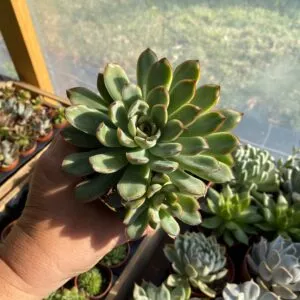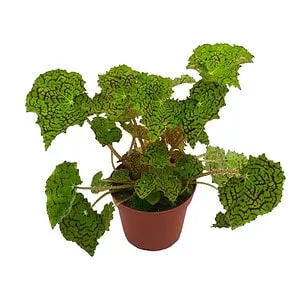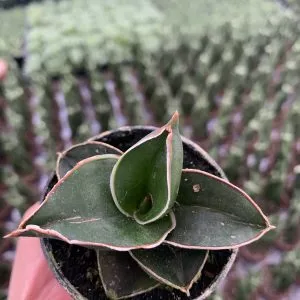No products in the cart.
Table of Contents
Do you want to add some color to your garden? Coral bells, the traditional perennial foliage plant, might be what you need.
Coral bells will indeed become a highlight of your ornamental display. The leaf variegation and color will catch the attention of people passing by.
So today, we will help you take care of the coral bells Heuchera that belongs to the plant family Saxifragaceae to keep your garden shining.
What Are Coral Bells Plants?
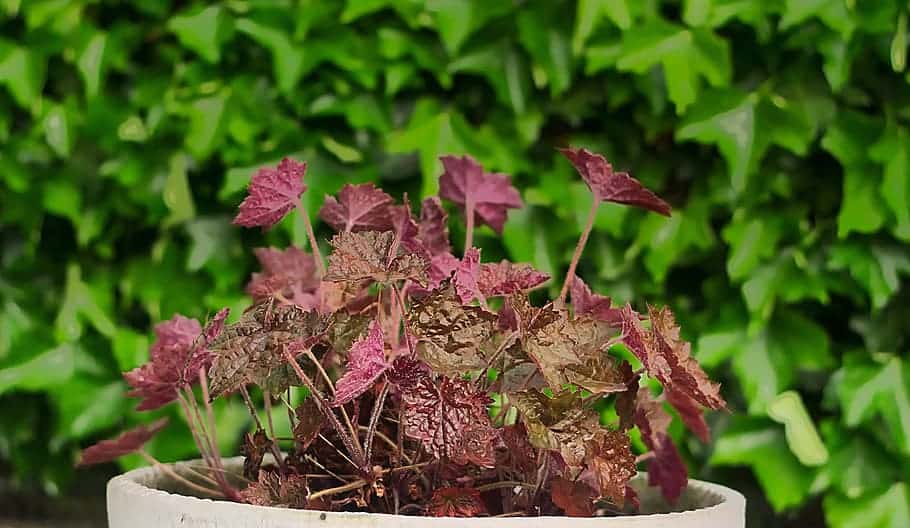
Many gardeners call the plant alumroot. It is a very adaptable foliage plant that you can find in different varieties. Established plants quickly adapt to a wide range of soil types and temperatures.
You’ll mostly see them growing throughout California and the Channel Islands. Sometimes you see them in Arizona or Mexico as well.
The flower stalks grow well in the shade and quickly adapt to most gardens. The plants form round mounds with a woody rootstock, the crown. Small bell-shaped flowers appear on the tall stems in spring or early summer.
So, you can expect many pollinators to make their way to your garden as the flowers also attract bees, butterflies, and hummingbirds. Yes, all of them are looking to get a bite of the rich nectar.
Meanwhile, the leaves are hairy with a round-lobed shape. Depending on where you live, you’ll find the foliage displayed in evergreen or partial green.
But it can also have shades of rose, lime, purple, gold, and more. The best time to plant coral bells is from late fall to early spring in shady locations.
They make an excellent option for borders, rock gardens; ground covers with other nearby flowers, and container-grown plants.
Coral Bells Plant Care
Caring for coral bells is low-maintenance, which is great for newbie gardeners. You can grow them in a container or treat them as an outdoor plant. It also makes for wonderful edging plants with foliage color standing out in early summer.
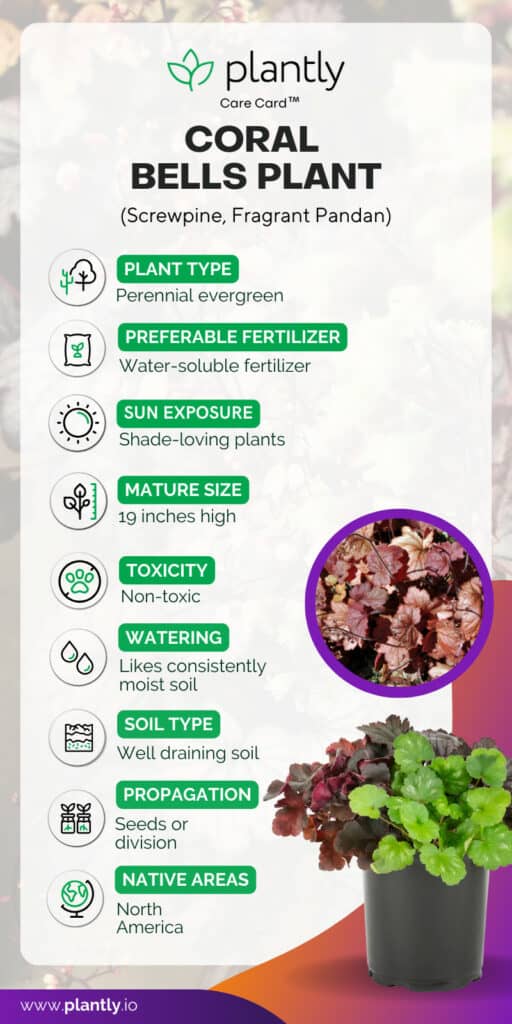
Best Soil Condition For Coral Bells
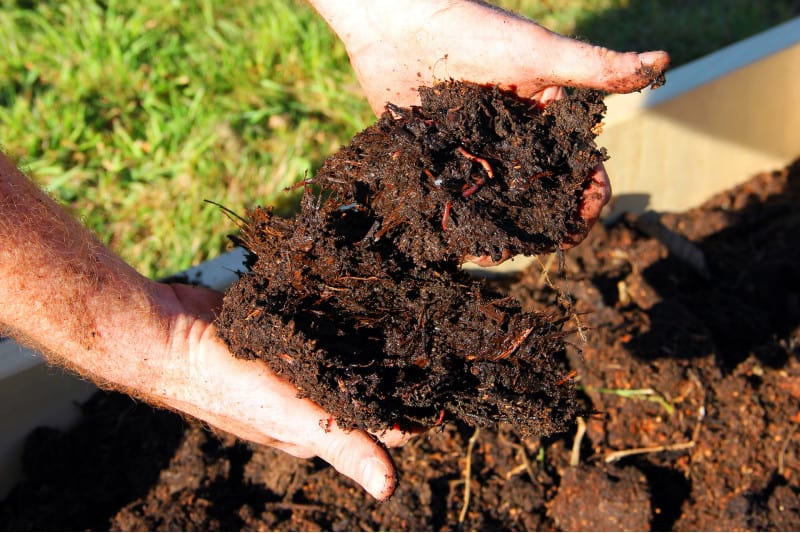
Growing wild, you find alumroots in crevices, steep slopes, and woodland settings. So they need good drainage to remain happy. Thus, it helps to use humus-rich soil filled with organic matter.
So, when you grow coral bells, prevent planting them in heavy clay soil. Instead, use sand and more compost before planting your foliage.
Neither does the foliage do well in dense soil; well-drained soil is essential as it causes crown rot.
Best Lighting Conditions
Coral bells are shade-loving plants, but they also do well in direct sunlight for up to six hours. With a landscape filled with other shade-loving plants, the flower color of lime green or yellow flowers glow in the garden.
Planting coral bells Heuchera in full sun is possible, but not too much sun, as it can damage the foliage color depending on your cultivar. For example, your darker alumroot can endure loads of sunlight.
But the semi-evergreen varieties of plants grow best in shade. Regardless, this beauty can survive and thrive if given the right amount of light treated as an indoor plant. Near a north or south-facing window would be ideal.
Watering Needs for Established Plants
As with any indoor plant, you need to provide them with enough water in the first year to help the root ball establish. Once your alumroot matures, it can survive in extreme conditions. However, the watering needs differ from one variety of Heuchera to another. So one cultivar can be a bit drought resistant while others are not.

While many gardeners believe the coral bells need damp soil, they can go without water for a while. Yet with regular watering, the foliage is more luscious and richer in color. Usually, an inch of water per week is plenty enough.
The trick is to press the ground around it using your hands. Then, water them until 1/2 inch of water gathers around them if grown in shaded areas. You may find that the soil needs more moisture in summer. If standing in full sun, place a half-inch layer of mulch over a soaker hose.
When winter arrives, you may decrease the watering. As with most plants, wet soil for too long can lead to root rot. So test the soil surface to know if it is dry.
Temperature and Humidity
Whether you have container-grown coral bells or standing in the garden, they will grow happily. Outside during winter, the coral bells’ crowns can rise above the soil line.
But some winter mulching helps to keep frost at bay and pushes them up. So check them to ensure the root systems are not exposed to cold temperatures.
Fertilizing
While feeding your perennial plants is not a must, an added boost of nutrients does help. Doing this allows the entire flower stalk to be healthier. In addition, your plants prefer feeding in early spring, and you can use half-inch layers of compost.

Or you can use a slow-release one for your garden plants and a water-soluble one for your container plants. So when you grow coral bells, only light feeding is needed, not to inhibit flowering.
Propagating Coral Bells
When it comes to reproducing your alumroot, you have two choices. The first is planting from the seed, and the other is division. However, if you use the seeds, your baby plant might not look like the parent plant.
Division
Sometimes coral bells produce offsets around the mother plant you can dig up and replant. These plants are short-lived, and you must divide them every four years to prevent them from dying. The best time to do this is in spring or early fall.
Please read this fascinating University of Minnesota Extension article on dividing perennials.
Take your shovel and dig up the entire root clump.
Then cut the clump into sections, each with growth shoots attached.
You can discard the woody portion.
Then prepare another site blended with compost; you can feel assured coral bells planted into this soil will surely thrive. Barely cover the root crowns and keep the divisions at the soil line.
Planting Coral Bells Seeds
To collect the seed, wait until it is established in your garden. Then remove the spent flower stalks once the blooms dry before the pods open. Or, you can buy the seeds as well. If you decide to plant the seed, you must do this in late fall or spring.
You can use a tray with soil and sprinkle the seed inside it. As with other plants, you need not cover them as they need the light to germinate. Please give them a misting with water and place them in a partially shaded warm area.
You can expect the seed to germinate within two to eight weeks. For fast germination, keep them indoors to transplant to the garden. For moving your foliage to the outside, you can harden them by placing them outdoors for a while.
USDA Growth Zone
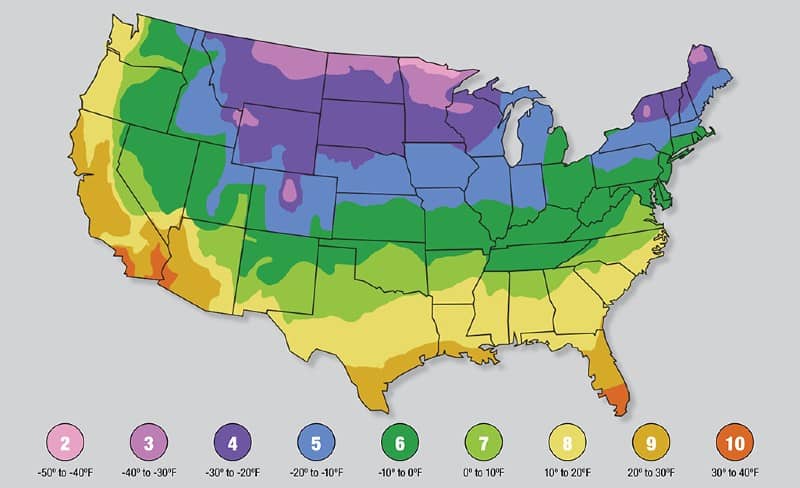
You can grow Heuchera plants in USDA hardiness zones 4-9. But you can also plant it in zones 3-11. The only time you need to take extra care of them is to protect the shallow roots in winter from frost.
Potting and Pruning
If you plant your alumroot in a container, provide enough drainage using a potting mix that drains water freely. It helps to keep the root crown higher than the ground. The same applies when planting Heuchera outside.
When grown in a potting medium, you can use fertilizer to feed coral bells with a water-soluble feed. While pruning is unnecessary, you can remove the spent flowers after blooming at the base. It helps with new growth and encourages repeat blooming.
But if your plant looks a bit ragged, remove the dead leaves to make them look healthier. Although never prune your plant back in fall, wait for spring when the new growth emerges.
Coral Bells Varieties
Here are other coral bells varieties that you may want to include in your collection for the flower color and foliage:
Heuchera ‘Autumn Leaves’

One thing you will love about this alumroot is the changing leaf color in accordance with the season change. You see the foliage changing from red caramel to a ruby shade.
Heuchera ‘Chocolate Ruffles’

The foliage has ruffled leaves with a rich chocolate color found at the top with a burgundy bottom.
Heuchera ‘Green Spice’
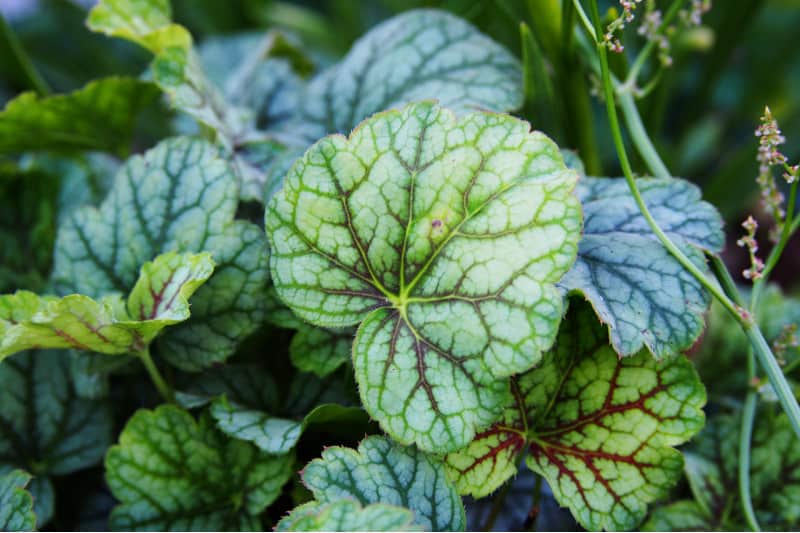
The alumroot is a hardy plant with huge green-shaded leaves with maroon veins. Placing this plant with other container combinations brightens up any spot.
Coral Bells Diseases & Pests
Luckily, coral bells rarely have problems. The most common issues you can have are as follows, and if grown indoors, we recommend placing them in quarantine so as not to cause infected plants with your other houseplants:
Fungal Diseases
The main concern is a fungal infection ranging from rust, fungal, and mold. If in a container, remove the infected plants and provide them with enough airflow. Also, make sure the water is draining well. Alternatively, you can use a copper fungicide.
Weevils
The other concern is weevils causing cosmetic damage or nematodes as well. You can treat it using neem oil or a mild insecticide.
Frequently Asked Questions
The coral bells have a mounding habit and can grow as tall as 16 inches up to 36 inches wide. Still, the flower spikes can reach up to three feet tall.
The best is to space them up to two feet apart as they grow wide depending if grown in partial shade or full sun.
When you plant coral bells in early spring or fall, they grow at a moderate speed. So they are ideal for growing in containers or a woodland setting to gardens.
Deer and other animals do not enjoy nibbling on coral bells, making it a favorite in the garden with the vibrant flower color.
If you live in zone 9 growing coral bells, choose a variety like the Heuchera villosa, a heat-resistant cultivar. Two other excellent varieties are the Caramel and Citronelle in this cultivar.
The Heuchera sanguinea grows well as container-grown plants and outdoors as it is cold and hardy and is mostly found at specialty nurseries. You can find different cultivars with vibrant flower colors.
Whether you want to buy, sell or simply reach out to other plant enthusiasts, Plantly is the right place to be!
-
$10.00Sold By: Smoot's Farm
In stock
Succulent Echeveria Mystery Green with Red Edge
Rated 4.89 out of 5 based on 27 customer ratings00Sold By: Smoot's Farm -
$10.99Sold By: BubbleBlooms
$12.99In stock
Deco Checks, Green Begonia Rex, 4 inch Painted-Leaf Begonia, Unique Homegrown Exclusive, Variegated
Only 87 available and it’s in 3 people’s basketRated 4.81 out of 5 based on 279 customer ratings00Sold By: BubbleBlooms -
$25.95Sold By: SunSoul Plants
$30.95In stock
Exotic Hibiscus ‘Chinese Lantern’ in 3″ pot
Rated 4.87 out of 5 based on 98 customer ratings00Sold By: SunSoul Plants -
$10.00Sold By: Cacti and Exotica
In stock
Sansevieria Samurai
Only 6 available and it’s in 1 people’s basketRated 4.98 out of 5 based on 59 customer ratings00Sold By: Cacti and Exotica
